
The Lost Weekend is a 1945 American drama film noir directed by Billy Wilder, and starring Ray Milland and Jane Wyman. It was based on Charles R. Jackson's 1944 novel about an alcoholic writer. The film was nominated for seven Academy Awards and won four: Best Picture, Best Director, Best Actor, and Best Adapted Screenplay. It also shared the Grand Prix at the first Cannes Film Festival, making it one of only three films—the other two being Marty (1955) and Parasite (2019)—to win both the Academy Award for Best Picture and the highest award at Cannes.

Anthony Adverse is a 1936 American epic historical drama film directed by Mervyn LeRoy and starring Fredric March and Olivia de Havilland. The screenplay by Sheridan Gibney draws elements of its plot from eight of the nine books in Hervey Allen's 1933 historical novel, Anthony Adverse. Abandoned at a convent as an infant, Anthony comes of age in the tumultuous turn of the 18th to the 19th century, the age of Napoleon. The audience is privy to many truths in Anthony's life, including the tragic story of his origins and the fact that the wealthy merchant who adopts him is his grandfather. Most important of all, Anthony believes that his beloved Angela abandoned him without a word, when in fact she left a note telling him that the theatrical troupe was going to Rome. The gust of wind that blows the note away is one of many fateful and fatal events in Anthony's story.

Dame Olivia Mary de Havilland was a British and American actress. The major works of her cinematic career spanned from 1935 to 1988. She appeared in 49 feature films and was one of the leading actresses of her time. At the time of her death in 2020 at age 104, she was the oldest living and earliest surviving Academy Award winner and was widely considered as being the last surviving major star from the Golden Age of Hollywood cinema. Her younger sister, with whom she had a noted rivalry well documented in the media, was Oscar-winning actress Joan Fontaine.
Blood Wedding is a tragedy by Spanish dramatist Federico García Lorca. It was written in 1932 and first performed at Teatro Beatriz in Madrid in March 1933, then later that year in Buenos Aires, Argentina.
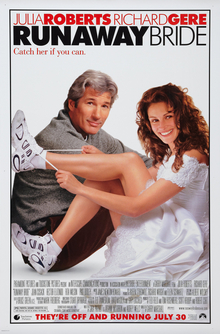
Runaway Bride is a 1999 American screwball romantic comedy film directed by Garry Marshall, and starring Julia Roberts and Richard Gere. The screenplay, written by Sara Parriott and Josann McGibbon, is about a reporter (Gere) who undertakes to write a story about a woman (Roberts) who has left a string of fiancés at the altar.
A Wedding is a 2004 comic opera based on Robert Altman's 1978 film A Wedding and was composed by William Bolcom with a libretto written by Robert Altman and Arnold Weinstein.
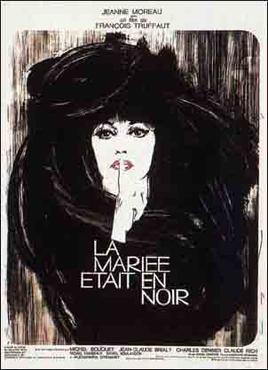
The Bride Wore Black is a 1968 French drama thriller film directed by François Truffaut and based on the novel of the same name by William Irish, a pseudonym for Cornell Woolrich. It stars Jeanne Moreau, Charles Denner, Alexandra Stewart, Michel Bouquet, Michael Lonsdale, Claude Rich and Jean-Claude Brialy. Hitchcock admirer Truffaut used Bernard Herrmann to score the film. The costumes were by Pierre Cardin.
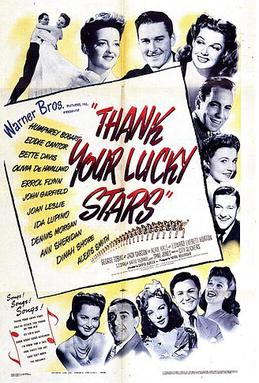
Thank Your Lucky Stars is a 1943 American musical comedy film made by Warner Brothers as a World War II fundraiser, with a slim plot involving theater producers. The stars donated their salaries to the Hollywood Canteen, which was founded by John Garfield and Bette Davis, who appear in this film. It was directed by David Butler and stars Eddie Cantor, Dennis Morgan, Joan Leslie, Edward Everett Horton and S.Z. Sakall.

Light in the Piazza is a 1962 American romantic comedy drama film directed by Guy Green and starring Olivia de Havilland, Rossano Brazzi, Yvette Mimieux, George Hamilton, and Barry Sullivan. Based on the 1960 novel The Light in the Piazza by Elizabeth Spencer, the film is about a beautiful but mentally disabled young American woman traveling in Italy with her mother and the Italian man they meet during one leg of their trip.
Carolyn Pizzuti is an American author of romance novels under the pen name Carolyn Zane. She has also been published as Suzy Pizzuti.

So Evil My Love is a 1948 British and American Gothic psychological thriller film directed by Lewis Allen and starring Ray Milland, Ann Todd and Geraldine Fitzgerald.

Smart Blonde is a 1937 American mystery film directed by Frank McDonald. Starring Glenda Farrell as Torchy Blane, a fast-talking wisecracking female reporter, teaming up with her boyfriend detective Steve McBride, to solve the killing of an investor who just bought a popular local nightclub.
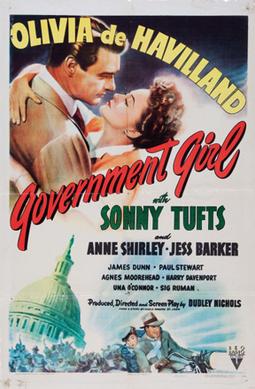
Government Girl is a 1943 American romantic-comedy film, produced and directed by Dudley Nichols and starring Olivia de Havilland and Sonny Tufts. Based on a story by Adela Rogers St. Johns, and written by Dudley Nichols and Budd Schulberg, the film is about a secretary working in Washington for the war administration during World War II who helps her boss navigate the complex political machinations of government in an effort to build bomber aircraft for the war effort.

The Royal Romance of Charles and Diana is a 1982 American made-for-television biographical drama film that depicts the events leading to the wedding of Prince Charles and Lady Diana Spencer. The film was directed by Peter Levin and starred Catherine Oxenberg, Christopher Baines, Olivia de Havilland, Dana Wynter, Stewart Granger and Ray Milland. It originally aired September 20, 1982, on CBS.
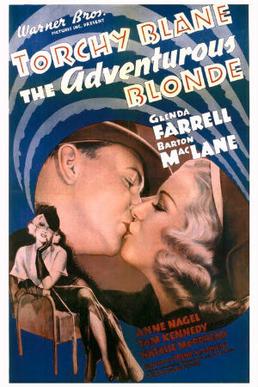
The Adventurous Blonde is a 1937 American comedy mystery film directed by Frank McDonald and starring Glenda Farrell, Barton MacLane and Anne Nagel. It was written by Robertson White and David Diamond. It was released on November 13, 1937.

Blondes at Work is a 1938 American comedy mystery film directed by Frank McDonald and written by Albert DeMond. The film stars Glenda Farrell and Barton MacLane. It is the fourth film in a series of Torchy Blane movies by Warner Bros. Released on February 6, 1938, it is followed by Torchy Blane in Panama (1938).

Torchy Blane in Panama is a 1938 American mystery film directed by William Clemens and starring Lola Lane, Paul Kelly, and Tom Kennedy. Released on May 7, 1938, the fifth film in a series of Torchy Blane movies by Warner Bros. It is followed by Torchy Gets Her Man (1938).
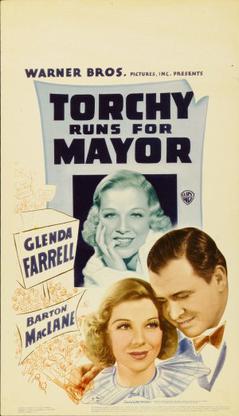
Torchy Runs for Mayor is a 1939 American drama-comedy film directed by Ray McCarey. It is the eighth film in the Torchy Blane film series by Warner Bros., and the last film starring Glenda Farrell and Barton MacLane as Torchy Blane and Steve McBride. It was released on May 13, 1939. The film is followed by Torchy Blane... Playing with Dynamite (1939).
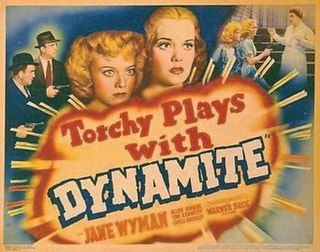
Torchy Blane... Playing with Dynamite is a 1939 American mystery film directed by Noel M. Smith, written by Earle Snell and Charles Belden, and starring Jane Wyman, Allen Jenkins, and Tom Kennedy. It was released on August 12, 1939.
Wedding customs in Ethiopia vary among the tribes of the country.
















